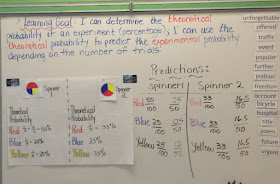CC licensed photo shared by Flickr user Duncan Hall
I believe that children learn about and develop an understanding of Probability through experience. For this unit, we play games and conduct experiments. We make observations and we record data. And then, together, we look at our results and we try to figure out how best to represent what we witnessed mathematically.
Children can't succeed with this unit unless they have a firm grounding in proportional reasoning. If you put in the time exploring fractions, percentages and decimals; if you make sure that students understand the relationships between fractions, decimals and percentages, then your students will be very successful with Probability.
We are only three days into this unit, and my students keep saying "This unit is so easy". What they don't realize is that it is only easy because they are using all of their knowledge about proportional reasoning to make sense of Probability.
Yesterday, I taught a lesson adapted from an activity from Marilyn Burns' Math Solutions course. I love this activity because it teaches students how to compare the Theoretical Probability to the Experimental Probability. Here is the original experiment. I adapted it by having my students compare the results of two different spinners. Each of the two spinners had three colours, but on the first spinner, red represented half of the spinner, and the other two colours each represented a quarter. On the second spinner the three colours each represented a third of the spinner.
For our "Minds On", we determined the Theoretical Probability for each spinner as a fraction. (Theoretical Probabilty = Favourable Outcome/All Possible Outcomes). Then we turned that fraction into a percentage. Once it was a percentage, it was easy to determine how what the Theoretical Probability would be for 100 trials for each colour on each spinner. Using equivalent fractions, we discussed how the numerator would change depending on the number of trials. Then we discussed how the percentage probability could be written as a decimal and placed on a number line where 0 is "impossible" and 1 is "certain".
I had the students write their predictions for the different number of trials on their personal white boards so I could quickly gauge who was understanding and who was not.
Then came the fun part - the Action. We had ten pairs of students working together. (One thing I've learned over the years: make your group sizes according to how many jobs there are to do. One recorder and one spinner means two kids in a group). Each group did fifty trials on each spinner. They recorded the results on grid paper I had made especially for the activity. It looked like this:
 |
You can see the students' individual whiteboards lying on their desks. We use these all the time. They use them instead of "scratch" paper. But mostly we use them for quick formative assessment. |
Once everyone had completed fifty trials for each spinner, the students cut out their strips and we attached all of the reds together, (they cut out strips but leave the "x's" on. We glue subsequent strips via the "x"), then all of the blues, then all of the yellows keeping the results from the two different spinners separate. (The children said they looked like long strips of ticker tape.) In total, we had done 500 trials for each spinner. Looking at the long strips we taped to the wall, it was apparent that for the first spinner, the red strip was twice as long as the blue and yellow strips, but for the second spinner, all three strips were just about the same length.
It took a long time for the students to complete all of the trials. But taking the time was worth it. This morning we started our math lesson with the Consolidation of yesterday's experiment. It wasn't long before they were able to explain to me that the more trials they did, the closer the Experimental Probability approached the Theoretical Probability, and as one of my students shouted, "that is just so cool!"
We were ready for a challenge after that! So for our Action today, I gave the students percentages for certain colours, and they had to work in groups to devise spinners that would result in the correct Theoretical Probability represented by those percentages. In a sense, it was working backwards from what they had done yesterday. They quickly realized that making spinners with 10 sections was the easiest way to complete the task since they had been given percentages.
As an Exit Ticket, I gave them an Open Response questions from last year's EQAO Assessment. My students found this question "easy".
Exit Ticket: Connor has a bag of coloured tiles. There are 1 green, 3 black, 5 blue and 6 red tiles. He reaches into the bag and chooses 1 tile without looking. What is the probability that the tile is not red?
Justify your answer.
Show the value of the probability on the number line below.
0 ____________________________________________________________________ 1
I am loving teaching this unit. When I take the time to create lessons that I enjoy and can be enthusiastic about, my students also enjoy the lesson and share my enthusiasm. When we are all having fun, everyone learns!







Thanks for giving such a wonderful sharing. Generally I don't read post on blogs, but with your writing taste i was pressured to try and do it. This is truly a great read for me. Keep penning:)
ReplyDeleteclover
www.n8fan.net